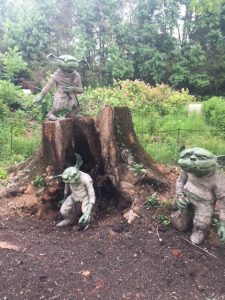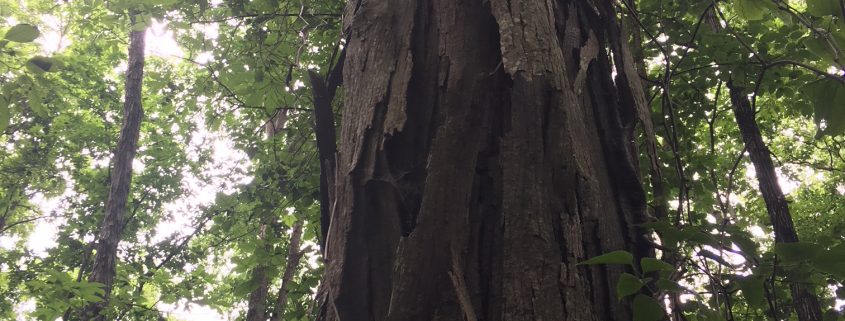Bark Portfolio — Beauty and Mystery
A Poem as Lovely as a Tree?
I’ve found fascination, entertainment, inspiration, wonderment, and joy in trees since toddler-hood! Poet Joyce Kilmer’s Trees captures my lifelong sentiment:
As a kind-of-writer, I’ve thought about communicating my addiction to Nature via the language of poetry. I have yet to take that bold leap. I suppose I am so taken with Nature’s magic, wonder, beauty, and awe, that I fear doing injustice to the real thing in a futile attempt at verse and meter. I’ll stick to prose for now.
I took freshman dendrology (the study of trees) 48 years ago. We learned to identify scores of central Appalachian tree species by leaf, twig, bud, bark, and flower. That course and thousands of forest practice hours since in our eastern forests enabled me to identify many species without so much as a glance into the canopy. I’ve learned that I can do it far more easily than I can explain. Like differentiating among our human friends and acquaintances, bark-based tree identification rests upon recognizing and mentally cataloging features of distinction.
Annie Dillard spoke indirectly to the art and science bases of such tasks:
[T]he notion of the infinite variety of detail and the multiplicity of forms is a pleasing one; in the complexity are the fringes of beauty, and in variety are generosity and exuberance.
Visiting a Forest Museum
These days on a woods walk, I see the beauty, generosity, and exuberance more clearly and appreciatively than ever. Tree identification no longer seems a sordid mechanical exercise. Instead, I peruse the forest and its trees in like fashion to visiting a museum and seeing works of art. Since returning from West Virginia late December, I have enjoyed perhaps a dozen hikes with two different groups. One group tours at museum pace; the other at what I’ll call point-to-point pace. The first walks appreciatively within the forest; the second scoots through the forest. June 8, 2018, I hiked through the forest at Monte Sano State Park, covering some 7.7 miles. I attempted to combine hiking through and within the forest. The result — peristalsis — I frequently halted to examine, appreciate, and photograph museum pieces, and then raced ahead to catch the group of through-walkers. Know that racing ahead at age 67 isn’t what it used to be! In this particular museum tour, I focused mostly on one type of exhibit — tree bark.
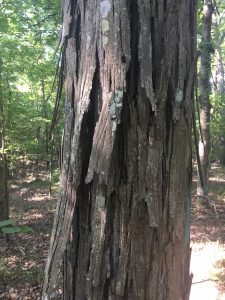
Shagbark hickory — such a work of art! I wanted to inhale its magic; imagine its mysteries; ponder its design. No way… I had to catch the group. Why did I focus for that day’s hike on tree bark? The Friday hike a week earlier, I walked within another Monte Sano forest with a museum-paced group, our hike abbreviated by an approaching thundershower. That hike piqued my current interest in tree bark. I decided to devote the next hike to viewing the bark displays. I offer an introduction to the study of native north Alabama tree bark with the photos below. Consider this museum-highlights Blog Post as a teaser… a beginning for future examinations.
I wonder whether our US southeastern region has a corollary to Michael Wojtech’s Bark: A Field Guide to Trees of the Northeast. Bark is a wonderful compendium of photographs and descriptions. I view it as a catalog of New England’s tree bark museum pieces. Dr. Tom Wessels, a forest ecologist and one of my world-class faculty members when I served as President, Antioch University New England, penned Bark‘s foreword. No wonder I respected and admired now-emeritus professor Wessels so much. We are kindred souls. He sees the forest as the work of art that it is:
The bark of trees has been relegated to the background for too long. With this guide, Michael Wojtech has prepared a forested pageant for our eyes. I encourage anyone who picks up this book to become acquainted with our sylvan neighbors, as I did more than 50 years ago, by the wonderful ways in which they cloak their strong frames.
I’ve not discovered a similar references for our southern forest museum.
I now offer a forested pageant sampler from my recent Monte Sano State Park peristalsis. I present this exhibit registry in no particular order. The inventory is not even fully inclusive of the species we encountered. Again, I did not have the luxury of time and pace to capture images of all species we saw. Perhaps I can begin to compile a more complete directory. In each case below I will identify the tree species (in some cases, species group) in text above the photo(s).
The sugar maple below left bears the trail identification marker for my own future reference. The larger twin sugar maples (below right) conveniently show verifying leaves from epicormic shoots. Note the sapsucker bird-peck on the larger stem just above the fork. Ah, each photo will tempt me with side-track observations. One I can’t resist — the “fork” is likely a union where two competing stump or roots sprouts conjoined as they expanded into one another.
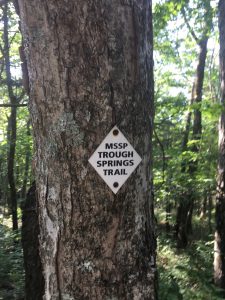
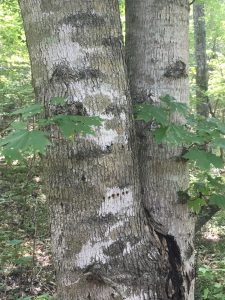
Red Oak is a species grouping. Both photos below show a red oak. As we walked through the forest, I did not take time to assign species. That will await my next hike within the forest!
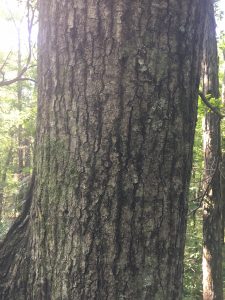

Eastern Red Cedar is a common pioneer species that invades abandoned pasture, road-sides, and other severely disturbed areas. An evergreen, red cedar has distinctive bark, seldom mistaken in aggregate characteristics for any other species. My experience throughout the eastern US is that most everybody recognizes and can name cedar.
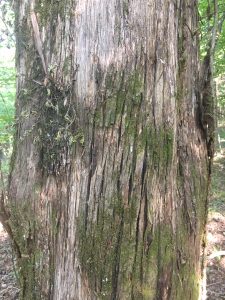
Buckeye (Ohio?) appeared occasionally along the lower slopes and richer sites across the distance. Once more, a distinctive bark… with broad plates and a gray hue.
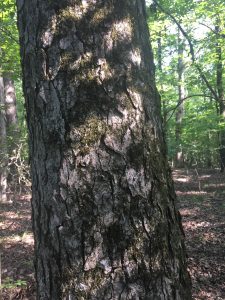
White Oak is another species grouping. I am reasonably sure that this is Quercus alba. Vertically oriented shallow peeling bark, a light gray color.
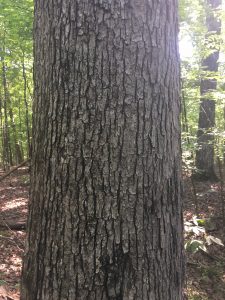
White Ash constituted perhaps five percent of the stems along our trek. Vertically patterned interlocking furrows, deepening with age and girth. One of my favorite species, ash is under distribution-wide threat from the emerald ash borer, already devastating the species south to mid-Tennessee.
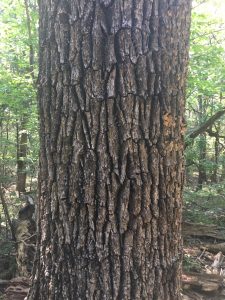
Black Locust, another pioneer species, is dropping from the forests we transected. I found far more dead stems than living. I would have predicted same. They just can’t live as long as the oaks and other mature forest associates. Somewhat similar to ash in bark orientation, the locust has a coarser pattern and deeper furrows.
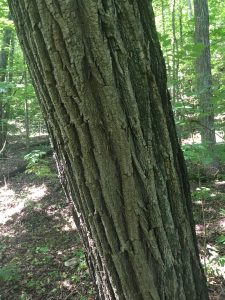
Paw Paw is an intermediate canopy dweller, occupying a vertical position beneath the main canopy. I find the bark non-descriptive. Without seeing the leaves, I would have lumped it into “other.” I have not spent enough time around it to recognize it.
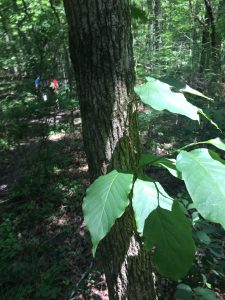
Chestnut Oak is another of the white oak group. I describe its bark as alligator hide, coarse and deeply furrowed. We found it most commonly on upper slopes and poorer sites.
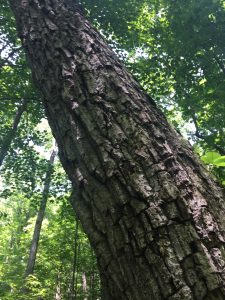
Black Cherry distinguishes itself with dark, finely plated flakes, aligned neither vertically or horizontally. The species holds a special place in my heart — Prunus serotina dominated the Allegheny Hardwood forests (NW PA and SW NY) where I conducted my doctoral research. It’s good to see it here in the South.
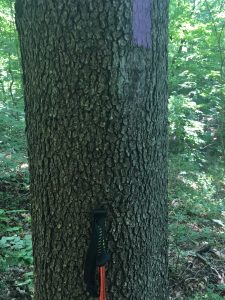
Sweetgum is, from my limited observation, the most widely distributed hardwood species across Alabama… a companion to loblolly pine from Tennessee to the Gulf. Vertically oriented shallow plates.
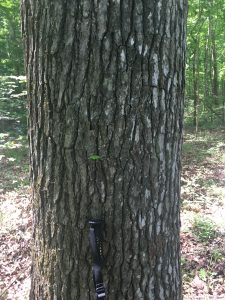
I often tell people tongue in cheek that Dogwood is identifiable by its bark. I’m having fun with words, but I am also speaking truthfully. Dogwood’s blocky, dark bark is unique… and instantly distinguishable. Add in a handful of sprout leaves and we have an indisputable i.d.
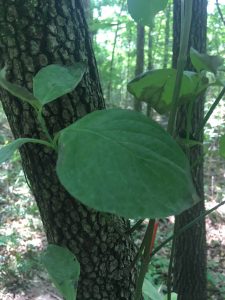
Persimmon bark resembles dogwood’s, only on steroids. Dark and deeply blocky. Persimmon does reach into the lower main canopy; dogwood is relegated to the lower tier.
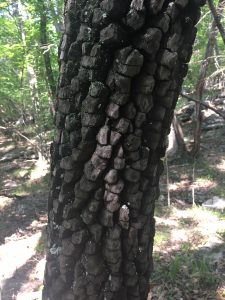
Loblolly Pine is our chief Southern Pine. I admit to relying upon a peek to the canopy needles to confidently differentiate among our native pines.
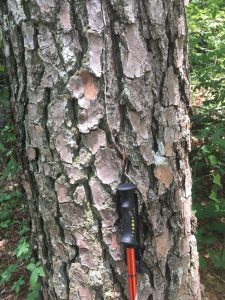
During the hike I rush-snapped this photo of an unusual bark. Already falling behind from several successive stops, I needed to once again close the gap with my fellow hikers. I presumed I would see another of what I am now referring to as a mystery species. I did not! I’m leading toward a hickory, but without any confidence. Note the mid-photo horizontal bird-peck.
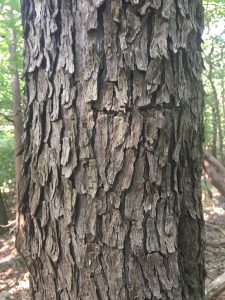
We ended the hike back atop the Cumberland Plateau. A fitting end with a great view… our first since emerging from the continuous closed canopy we entered at the parking lot trail head.
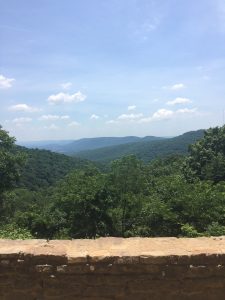
Branching Habits — Yet Another Forest Museum Exhibit Category
Bark employs exquisite photos of tree bark by species and stage of maturation — sapling through old growth. I found a related volume during my exhaustive doctoral literature search, The Adaptive Geometry of Trees (Henry S. Horn, 1971). Horn employed meticulous and detailed line drawings of branching form, offering explanations for the adaptive competitive advantages linking form and function:
Botanists seldom give much thought to the shapes of whole plants, perhaps because the growth habit of most higher plants is a repeatedly branched system of units of variable number. It is the form of the units (leaves, flowers, roots) that provides most of the material used by descriptive botanists. The parts, however, are linked to make a more or less integrated whole, a light-trapping, gas exchanging, water-conducting wick extended between the water and nutrients of the soil and the sunlit desiccating environment of the air. The form of this whole may be expected to matter very much, and if adaptively critical elements in form can be isolated and measured we may expect to have a tool of great value for comparing species and understanding the working of plant communities. [This book] is almost wholly an analysis of the effects of leaf arrangements on the trapping of light.
I think we can accept that branching form is a mechanism for seeking and securing competitive advantage. But what about bark pattern, color, coarseness, and other elements of form contributes some advantage? I have no idea, nor will I speculate with this Blog Post. Does anyone care beyond the squirrel, bird, lizard, snake, raccoon, vine, resurrection fern, or other aerial tree-dwellers?
I’ll do a little more homework before I revisit this subject in some future Blog Post.
Novel Forest Museum Art
I seek Nature’s forest oddities, reserved for display in museum nooks and crannies… seldom advertised… always surprising, captivating, and rewarding. Like trees, vine species evidence distinctive bark. I needed more time to fully appreciate these specialty collections. This five-inch-diameter grapevine is about as large as I have encountered.
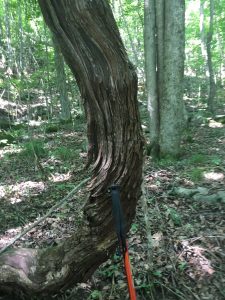
Poison ivy’s bark carries a shaggy mane, distinguishing it from other forest vines. Like the grapevine above, this is a particularly large poison ivy stem.
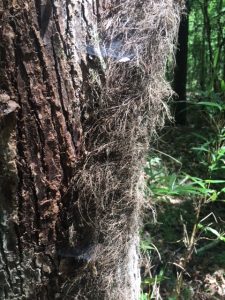
I had once again already fallen behind when I found this museum piece: “Spider in Twisted Vines.” A genuine work of art!
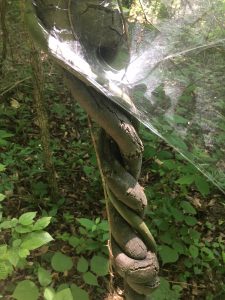
Once again, as I hurried through the woods I glanced to my left to see ET peering at me from a shagbark hickory. I considered offering him my digital device to Phone Home!
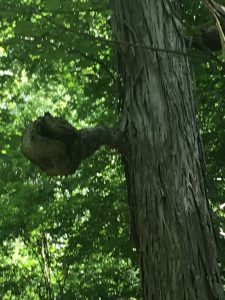
Ah, if only I could have lingered more along the way!
Reflections and Lessons
I’ll repeat from above:
I think we can accept that branching form is a mechanism for seeking and securing competitive advantage. But what about bark pattern, color, coarseness, and other elements of form contributes some advantage? I have no idea, nor will I speculate with this Blog Post. Does anyone care beyond the squirrel, bird, lizard, snake, raccoon, vine, resurrection fern, or other aerial tree-dwellers?
I’ll do a little more homework before I revisit this subject in some future Blog Post.
The same questions and mysteries apply as well to other tree features, including: wood; leaves; roots; buds and twigs; chemical by-products; flower and fruit; insects and diseases; animal inhabitants. I recall an old Pennsylvania Dutch idiom, “The hurrier I go, the behinder I get.” Such was the case with me on this too-quick journey through the forest.
I believe I know now more than I ever have, yet I now realize how little I do know. A Bob Seger tune includes these lyrics: “Wish I didn’t know now what I didn’t know then.” Sometimes, he suggests, things are simpler when less complicated and unburdened with wisdom, knowledge, and experience. Yet those very contemplations and musings enrich my visits to the local forest museum. Each hike within the woods offers yet another forested pageant for my eyes. I’m grateful for all that I’ve learned and know, for every iota of knowledge and wisdom serves as a lens for deeper appreciation for and celebration of Nature.
Once again, it is Nature’s beauty, magic, wonder, and awe that inspire my life and add value to every day. As I so often urge… learn, practice, and hone all five verbs critical to deeply appreciating life: Believe; Look; See; Feel; and Act. Become an informed and dedicated Earth steward. Commit yourself to making tomorrow better and brighter.
Embrace Nature-Inspired Living, Learning, Serving, and Leading!
Postscript
I’ve said, “Believing is Seeing.” Well even I have my limits!
